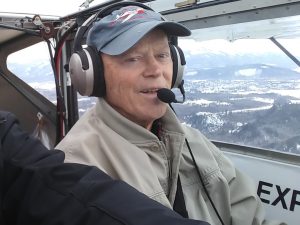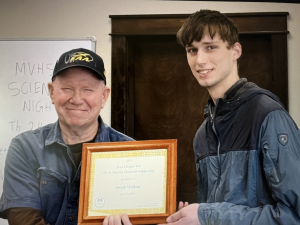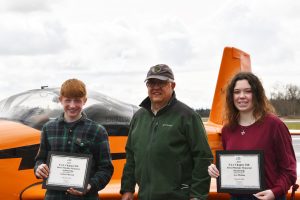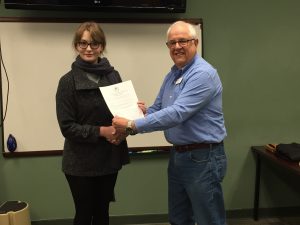The David Mischke Memorial Aviation Scholarship Program
To print the application click here and mail to:
Larry Buerk
637 Race Road
Coupeville, WA 98239
The Burlington, WA, Chapter 818, of the Experimental Aircraft Association (EAA), has a goal of promoting and furthering youth aviation education and flight training. To assist in meeting that goal, the chapter will award an aviation education/ flight training scholarship to an area high school, home school, or college student. The scholarship is currently in the amount of $2,000 to be used to start or continue flight training to attain the Private Pilot Certificate. The goal is for the student to utilize these funds within six months for the sole purpose of aviation education/ flight training.
The recipient of the 2025 Mischke scholarship is Josiah Walkup. Josiah expects to start his flight training the summer of 2025. Doug Seward, the chair of our Mischke scholarship committee, awarded the scholarship at the April 2025 chapter gathering.
Chapter membership chairman Bob Savage giving our second group of scholarship recipients their certificates; Ava Melton and Gabriel Bryant both are already working on their Pilot’s license. Careers to follow?
The first scholarship recipient was McKenzie Nielsen-Barrett. Here we see McKenzie receiving the scholarship from Bob Savage.
We accept scholarship applications between January and the end of February, and we select the scholarship recipients by the end of March.
To qualify for the scholarship the applicant must:
- Complete the scholarship application, to include a 500 word essay on why they want to be a pilot and identifying their future career goals relating to aerospace and aviation.
- Complete an EAA Young Eagles flight and register for the FAA Ground School online program offered through Sporty’s Pilot Shop and EAA. You will become an EAA member for free by completing a Young Eagles flight. Scholarship candidates 18 and older can complete an EAA Eagle Flight. You will need to register for an FAA Ground School and become a member of EAA (free for 6 months after an Eagle Flight).
- The scholarship candidate will be required to take an orientation flight with an EAA Chapter 818-designated flight instructor or a designated chapter member. This flight will help to determine the candidate’s interest and potential ability to complete flight training. The student will also need to participate in an interview with the EAA Chapter 818 scholarship selection committee. Once selected, the candidate shall apply for an FAA Student Pilot Certificate and pass a physical exam with an FAA designated aviation medical examiner for a third-class medical certificate.
- Be able to contribute their financial resources to complete Pilot Training. The scholarship student will be responsible for 10% of the flight training and will need to provide a $200 deposit designated for flight training fees before any training begins. This deposit will cover $2,000 in flight training costs.
- If currently enrolled in school, the recipient must maintain a 3.0 GPA or better.
- Be willing to join Chapter 818 as a student member ($5 annual dues), maintain a diary of their flight training and advise the Chapter of their progress.
- Be willing to attend EAA Chapter 818 monthly activities and meetings while participating in flight training.
- Be willing to maintain a flight training schedule that will provide for a flight lesson at least once a week. Flight training will not be effective if lessons are not scheduled consistently. You will have 1 year to utilize the scholarship funds. If they are not used within one year the Scholarship will expire. Scheduling of flight lessons will require flexibility due to weather conditions and other factors. If your schedule is too tight with other commitments and you are not able to be flexible, and if your flight training is not a top priority, please do not apply. The candidate will need to pass the FAA Private Pilot Ground School exam prior to beginning extended flight training, and passing the exam is a requirement for a Private Pilot Certificate.
What do I need to start my flight training?
For the most part, you can show up for your first flight lesson with nothing more than a primed eagerness to enjoy an exhilarating experience! The airplane and fuel are included in the cost of your instruction, so all you need is your desire to learn to fly.
Here are the basic qualifications:
- Be at least 16 years old to start flight training in airplanes and helicopters, 14 for gliders and balloons
- No criminal record
- Be able to read, speak and understand English
- Prior to your first solo (without your instructor) flight, application for your Federal Aviation Administration (FAA) Student Pilot Certificate shall be made and a successful physical exam by an FAA medical examiner will be required. Your flight instructor will assist you with the requirements. See faa.gov/pilots/become/student_cert/.
Time and Cost
Learning to fly is easier, more affordable, and less time-consuming than you think. The cost and length of flight training varies by which type of pilot certificate you choose to earn, the type of aircraft you learn to fly in, the frequency of flight lessons, and your location. While each certificate requires a minimum number of flight training hours, there’s no set duration for training. The best way to progress quickly is to fly consistently and to study what you’ve learned between flight lessons. This scholarship will give you a start on achieving your goal.
Once you become a pilot, there are many ways to reduce or share the cost of flying with other like-minded pilots. Those options include renting aircraft versus buying, aircraft partnerships, flying clubs, and membership in your local EAA chapter, where you’ll have opportunities to participate in the fun of flying year-round in your community.
Private Pilot
The minimum age to hold a private airplane or helicopter certificate is 17, or 16 for a glider or balloon. The private pilot certificate requires a minimum of 40 hours of flying time and allows you to fly single-engine aircraft with multiple passengers, day or night, and over unlimited distances. With additional training, you may also fly in weather that exceeds visual flight rules (VFR) conditions. Each certificate has its place, depending on your wants and needs. And, since most of what you’ll learn can be applied towards a higher certificate, they’re all equally good starting points, as getting started with your training.
Flight Training Milestones
So, what does it take to become a pilot? Here are the major milestones in the flight training process. After successful completion of these achievements, you’ll be a competent and safe pilot, ready to fly with friends and loved ones as passengers.
Dual Instruction
This is the phase of flight training that entails having your instructor with you in the flight training aircraft. The majority of hours flown before obtaining your license will be with an instructor. During dual instruction, your CFI will train you in all the necessary skills required to pilot an aircraft.
Solo Flight
One of the major milestones in learning to fly is your first solo flight. Ask any pilot, and they can vividly recall the details of the first time they flew solo. When your instructor believes you’re ready, he or she will set you free to fly on your own as you work toward the completion of your flight training. Before you engage in solo flight training, you will need a student pilot certificate issued by the FAA, which also requires an FAA third-class medical certificate.
Written Test
Along the path to becoming a pilot, you’ll have to make time to study some academic materials to pass the FAA Knowledge Test. This is often referred to as the “written” because it is a 40 question, multiple-choice test. You must score 70 percent or better to pass. To prepare for the test, you can train with your instructor, take an in-person class (called “ground school”), or complete an online self-study course. This test can be taken at any time in your flight training but you must complete it before you can takethe practical flight test, commonly called the “checkride.”
Cross-Country Flight
For the private pilot certificate, an important element of your flight training will be to conduct several cross-country flights–that is, you’ll depart from one airport and land at at least one other airport before returning to your home field. This exercise will ensure your ability to fly and navigate. Your flight instructor will oversee the planning for each cross-country flight, but most of your cross-country hours will be solo.
Oral and Practical Test
Once you’ve completed the different flight training requirements and your flight instructor is satisfied with your training, you will need to pass a “check ride.” The check ride entails an oral exam followed by a hands-on flight test that you’ll need to pass to obtain your pilot certificate. You must take your check ride with an FAA designated examiner who will test your knowledge, practices, and proficiencies at the controls.
Once you become a pilot, you’ll likely be looking for every possible opportunity to get out and FLY! You might plan an ambitious coast-to-coast trip, fly away with a friend for a weekend getaway, or spend a few hours practicing at the local airport. Or maybe you’ll use your newly acquired skills to travel for business. Whatever your plan, it will center on enjoying the work for a different perspective, and feeling the exhilaration, freedom, and satisfaction of flying an aircraft yourself.
Medical Requirements: Before you fly solo, you’ll need to apply for a student pilot certificate from the FAA. Additionally, the applicant needs to successfully complete an Airman’s physical exam administered by an FAA-designated aviation medical examiner. In addition, every pilot–from sport pilot to airline transport pilot–must determine before each flight that he or she is medically fit to operate their aircraft safely. As a pilot, it is your responsibility to ensure that your current medical health in no way jeopardizes the safety of a flight.




